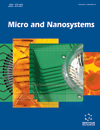- Home
- A-Z Publications
- Micro and Nanosystems
- Previous Issues
- Volume 15, Issue 2, 2023
Micro and Nanosystems - Volume 15, Issue 2, 2023
Volume 15, Issue 2, 2023
-
-
Internet of Things- Implementation in Healthcare with Telemedicine & Robotic
More LessSmart healthcare is a healthcare delivery method that utilizes wearable devices, the internet of things, and the mobile internet to dynamically access information, connect people, materials, and institutions in the healthcare industry, and then intelligently monitor and respond to the medical ecosystem requirements. The concept of smart healthcare has progressively gained traction as information technology advances like Te Read More
-
-
-
Nanostructured Lipid Carriers for Targeting Central Nervous System: Recent Advancements
More LessAuthors: Smriti Ojha and Sudhanshu MishraBackground: Lipid nanocarriers (NLCs) have undergone significant research over the past two decades to determine how well they target drugs to important parts of the human body, such as the central nervous system (CNS), the heart region, tumor cells, etc. Objective: The objective of this review paper was to review and critically summarize recent progress in NLC for targeting CNS. Methods: The structure, classification, el Read More
-
-
-
A Conceptual Framework Towards the Realization of In situ Monitoring and Control of End-to-End Additive Manufacturing Process
More LessAdditive Manufacturing (AM) is considered one of the key technologies for realizing Industry 4.0. There are numerous stages in the end-to-end AM process, including component design, material design, build, and so on. An enormous amount of data is generated along the end-to-end AM process that can be acquired from the 3D printer in real-time, micro-characterization studies, and process plan details, among others. F Read More
-
-
-
The Thermal Time Constant of an Electrothermal Microcantilever Resonator
More LessBy Musaab ZarogBackground: The thermal time constant is the core parameter for determining the dynamic response of the electrothermal actuators and the corresponding maximum operational frequency. Aim: Since it is necessary to determine how the thermal actuation occurs within the cantilever, this paper presents two models for the thermal time constant of bimetal microcantilevers. One model is based on the bimetallic effect, and t Read More
-
-
-
Synthesis and Photocatalytic Activity of Si-doped TiO2 Nanotube/SnS Hybrids for Environmental Decontamination
More LessAuthors: Ning Ma and Hai-Yan HeBackground: Heterostructures with nanoscale sizes have great superiorities in photocatalytic environment decontaminant because of their efficient interface charge transfer and great surface area. Objective: This work reports the facile fabrication of nano-tubular TiO2 and Si-doped TiO2 (NTs) hybridizing SnS nanocrystallites and their high-efficient photocatalytic activity. Methods: The modified hydrothermal processes were use Read More
-
-
-
Multi-Color States of High Contrast Nano Prussian Yellow Electrochromic Film
More LessAuthors: Abeer Baioun and Hassan KellawiAim: Construction of electrochromic device via Prussian yellow nanofilm on glass electrode. Background: Energy conservation is one of the primary research topics nowadays. Electrochromic devices with low power consumption and short stable switching periods are well suited to energyefficient applications, e.g., smart windows, car mirrors, displays, and electronic papers. Objective: Preparation of electrochromic Prussian yellow Read More
-
-
-
Chitosan-grafted Microspherical Loaded In-situ Gels for Enhanced Transdermal Delivery of Roxithromycin: In-vitro/Ex-vivo Assessment
More LessAuthors: Pankaj Singh, Amit K. Dubey and Rahul Kumar SinghBackground: Atleast once in life everyone experience different kinds of dermal diseases and the conventional dosage forms having a high rate of side effects. The discussed method is a better and alternative approach in case of patients’ compliance and sustained drug release. Objective: The objectives of this study are to prepare solid dispersion for enhancement of solubility of roxithromycin, encapsulation of solid dispersion i Read More
-
-
-
In-situ Photo-deposition of Nd-modified Hexahydroxy Strontium Stannate Nanorods with Enhanced Photocatalytic Performance
More LessAuthors: Zizhan Sun, Xiaoyu Wang, Zeyang Xue, Zhengyu Cai, Chuangang Fan and Lizhai PeiBackground: Metal surface modification of the photocatalysts is effective for enhancing the photocatalytic properties of the semiconductor photocatalysts. Nd can be used as the modified metal for the enhancement of catalytic performance of the strontium tin hydroxide (SrSn(OH)6) nanorods due to expanding the light absorption range and reducing the recombination of the photo-generated electrons and holes. Obje Read More
-
-
-
The Truncated Cone Effect in AFM Nanoindentation on Soft Materials
More LessAuthors: Stylianos-Vasileios Kontomaris and Anna MalamouBackground: Atomic Force Microscopy (AFM) nanoindentation is the principal method for the characterization of soft materials at the nanoscale. In most cases, pyramidal tips are used and approximated to perfect cones. However, the extended use of the AFM tip may alter its sharpness. Objective: In many cases, a truncated cone shape is appropriate for tip modeling. In this technical note, the equation that relates the for Read More
-
Most Read This Month
Article
content/journals/mns
Journal
10
5
false
en


